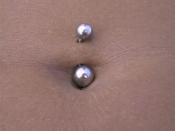Throughout history body piercing has been practiced by many cultures for many centuries. Body piercing was often identified with royalty and portrayed courage and virility. Egyptian Pharaohs pierced their navels as a rite of passage. Roman soldiers pierced their nipples to show their manhood. Mayans pierced their tongues as a spiritual ritual, and both sexes of Victorian royalty chose nipple and genital piercing. But is body piercing safe?
Body piercing and tattooing are unregulated in most U.S. states and are even illegal in some. Since body piercing has become popular, shops have sprung up everywhere with little or no regulation and very little incentive to take precautions against infections or other health hazards. Piercers do not need to be certified or go through training and there are places that don't even have a sink to wash the blood off of their instruments.
So just how bad is body piercing? Well, the American Dental Association opposes oral piercing, calling them a public health hazard.
The American Academy of Dermatology has taken a position against all forms of body piercing except for the ear lobe, which is less prone to infection. Both the U.S. and Canadian Red Cross won't accept blood donations from anyone who has had a body piercing or tattoo within a year because both procedures can transmit dangerous blood-borne diseases.
If you choose to have a body part pierced you also run the risk of prolonged bleeding, allergies from the jewelry used, and even infected cysts under the skin of the piercing which may have to be surgically drained. Your mouth is the perfect warm, dark, moist haven for bacteria to form and the extremely thin skin of your eyebrow can be sensitive to infection. If the cartilage in your nose gets infected or has a blood collection, there...


